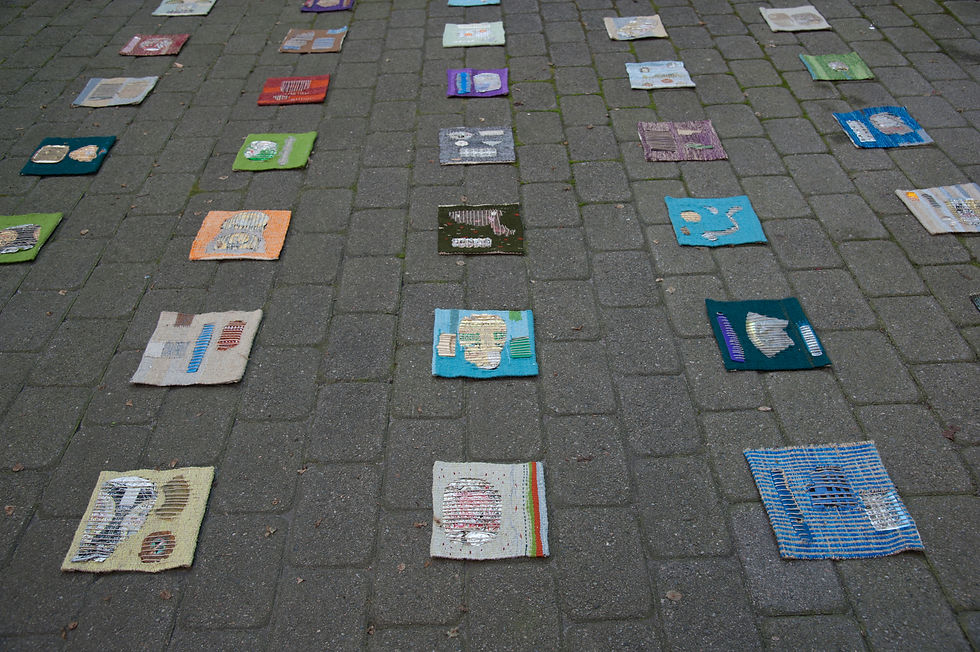RAW WAR ongoing project since 2003
Anti-War
My profound outrage at the invasion of Iraq 2003 generated an intense need to protest against war. It became the initial source for this series of tapestries. The Syrian civil war, the Israel – Palestine conflict, the crisis in the Ukraine, and current attitudes to nuclear disarmament, are situations and issues that resonate in the later works.
The extreme opposition that exists between the aesthetics of tapestry and the horror of contemporary warfare define these works.

Blood cannot be washed out with blood, 2010. 280 x 250 cm

Blood cannot be washed out with blood, detail

Apocalypse now, 2009-2010. 280 x 250 cm

Apocalypse now, detail

Dona Nobis Pacem, 2012. 280 x 250 cm

Raw is War, War is Raw, 2008. 240 x 100 cm

Raw War, 2003. 140 x 140 cm

Raw War, detail

RAWAR, 2003. 240 x 120 cm

Guantanamo, 2009. 73 x 104 cm

Shrouds, 2008-2012. 80 x 120 cm X 7

Shrouds, detail

Poisonous Web, 2015. 280 x 150 cm

WON NOW, 2007. 240 x 100 cm

WON NOW, detail
CLIMATE CHANGE ongoing project since 1995
Predictions and prospects
Various works, sketches and work-in-progress
Past – Present – Future
The compelling evidence of global warming, how human activity has significantly altered the natural environment, and other questions regarding the future of the planet are ideas and reflections that inform this group of works.
The works are about perceiving an exquisite and abundant yet vulnerable and precarious planet.

Artificial June, 1995. 49 elements, 10 x 30 cm each

Artificial June, detail

Sky Pockets, 1996. 100 elements, 4 x 16 cm each

Sky Pockets, detail

Greenhouse, 2007. 250 x 250 cm

Turning a Summer Sky, 2011. 20 x 20 cm
YARN 1994
"Jeg stoler"
Sixteen chair pieces with accompanying stories.
Imprints of naked bottoms represented as woven images on the seats of the actual chairs. Each chair, or group of chairs, is presented together with an anecdotal text inspired by the look and character of the chair.

Entrust

Duo

Folding chair

The frog chair

Sailor’s chairs

The secretary

Shelter Hotel

The tram conductor’s lament
THE FABRIC OF CONVERSATION 1994
Miniature scenes: doll's house chairs with miniature tapestries that allude to various aspects of dialogue.
Selection of four from a series of sixteen individual works, 20 x 20 cm, various heights.

Ignored

Monologue

Mumbling

Surprise
FINDS F. UNN 1995 - 2005
Gutter archaeology.
Litter, refuse, wasted objects, picked up from the street and recycled as part of decorative tapestries.

F. UNN, 4 pieces, 20 x 20 cm each

F. UNN, 1997-1998, detail

Detail: Membrane, 1998. 323 x 30 cm

Comb (hair), 2000. 30 x 30 cm

Comb (tortoise), 2000. 30 x 30 cm

Spanish Combs, 30 x 30 cm, detail 5

Spanish Combs, 30 x 30 cm, detail 8

Spanish Combs, 30 x 30 cm, detail 9

Spanish Combs, 30 x 30 cm, detail 11

Detail: Sea of Tranquillity, each element 10 x 10 cm

Sea of Tranquillity, variation V, 2000-2009

Sea of Tranquillity, 2000-2005. Variation I: 1030 elements
LANDSCAPE AND THE NATURE OF TAPESTRY 1977 – 1993
Moving from Leeds, a large industrial town in England, to the midst of nature in Norway, made for changes in life and art. A re-examination and re-evaluation of tapestry as a contemporary art form was inevitable.
The developments of this period are rooted in the understanding and use of the intrinsic plastic qualities of tapestry construction. Unique to the structure of tapestry is the two-sided property of the woven fabric: two sides united by one and the same image. A tapestry is a durable material, that can be folded, twisted, or knotted and still retain the unity and visual logic of the woven image.
The surrounding landscape and the passing of time so perceptible in the changing seasons had a significant impact on my work during this period.

Stone Heads and Black Apples, 1980, 77 x 147 cm

Stone Heads and Black Apples, detail

Unopened Letter, 1981, 200 x 250 cm

Echo, 1982-83, 40 x 2000 cm

Dark Swimmer, 1983-84, 265 x 100 cm

Dark Swimmer, detail

Soft Fence, 1985, 153 x 260 cm

The Thaw (Råk), 1987-89, 280 x 20 X 12 cm

The sea is waving, 1989, 50 x 50 cm X 30

Winter Solstice, 1990, 200 x 250 cm

Running Hare, 1993, 40 x 610 cm

Cracks in the ice, 1989, 1400 x 30 cm
THE NEAR AND THE DEAR 1963 – 1977
In the sixties and most of the seventies I lived in Leeds, England. Coping with a foreign country and culture, raising a family, teaching experimental textiles in a fine art department, and formulating my own artistic practice, was all part of my hectic daily life. Through the immediacy of drawing and the methodical construction of tapestry I structured this initial chaos, and gave it form.

Åkle II, 1964

Mask, 1965. 109 x 93 cm

We are growing old together, 1971. 260 x 240 cm

Tricks with Principles,1972. 160 x 174 cm

Everyone Talks about the Weather…, 1972. 213 x 150 cm

Desert Wandering, 1974. 200 x 250 cm

Circus, 1975. 200 x 250 cm

Circus, colour sketch, 1975

The Bathers,1975. 200 x 200 cm

Aireborough Pool (Mikkel), 1977. 120 x 195 cm.

Recorder (Sunniva),1977. 300 x 30 cm

Gossip, 1977. 200 x 200 cm
ETCHINGS

Etching. 1976. 20,2 x 20,2 cm

Etching. 1976. 20,4 x 20,1 cm

Etching. 1976. 20,2 x 20,3 cm

Etching. Cirkus. 1970s. 25,7 x 22,7 cm

Etching. 1976. 20,2 x 20,2 cm

Etching. 1973. 25,5 x 20,3 cm

Etching. "Knekt/Knight" 1970s. 29,7 x 22,7 cm.